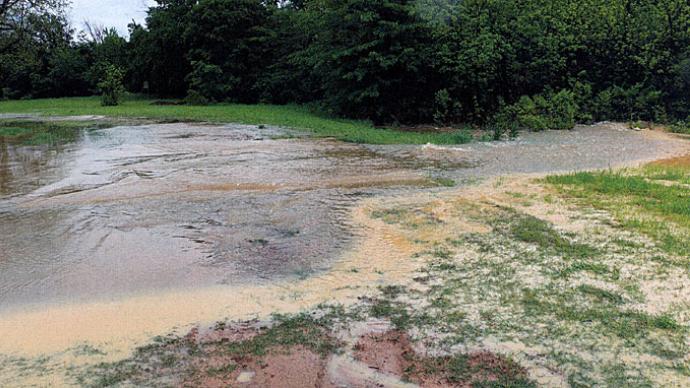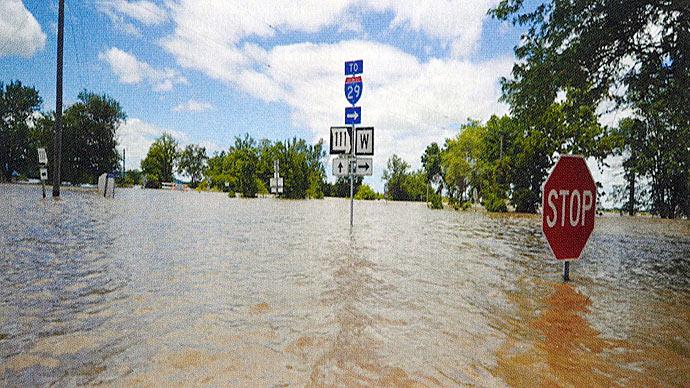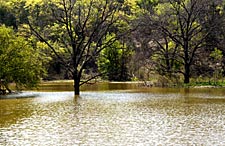
Seems weather has a steady seat at the news desk this year. Floods have occurred all over the upper Midwest into the eastern part of the country and down the Mississippi River into the delta, purging into the Gulf of Mexico. Along the way, farmland, homes... and lakes, are inundated with excessive amounts of water. Severe drought throughout Texas and parts of the southwest. Scorching summer temperatures, much hotter than "normal" this summer in much of the nation.
What impact does drastic weather have on your lake?
Quite a bit, actually.
During floods, species of plants, insects, invertebrates and fish move around. When water connects, it creates a freeway for free movement. That doesn't necessarily mean you'll wind up with bighead carp if a tributary of the mighty Mississippi backed up and spilled a little bit into the watershed of your farm pond. But, it might. Don't be surprised to hear tales of fish swapping homes during a flood.
It doesn't necessarily mean your fish will go away, either. But, they might...depending the severity and duration of the flood. If your lake connects for a day with moving water, you are more likely to receive fish than give many away. If you have a good home and plenty of food, your best fish aren't motivated to go anywhere. But, fish from neighboring watersheds may just find their way to your place. Don't be surprised to see sunfish species or unwanted critters as gar and carp move in and call your pond "home".
I got a call from a Texas county agent recently. The Lone Star State is in a devastating drought as I write. Several large west Texas reservoirs are dry...not low, but dry. O.C. Fisher reservoir, outside San Angelo, is bone dry. So is Baylor Reservoir near Childress. Lake Meredith, north of Amarillo in the Texas panhandle is 90% low. This is an historical drought.
The county agent has a cooperator who wishes to renovate a pond while at its low point. His question, "How much rotenone does it take to eradicate gar?" My answer? Where'd the gar come from?" With pause, he said, "I'm not sure". As we wade through record heat and fast evaporating water, it's easy to decide to renovate a pond. But, in this case, if they do away with the gar without considering how they traveled into that pond in the first place, they aren't solving a problem...they are just one flood away from restocking with more of the same.
In this case, eradicate the fish, but give some thought and effort to preventing their re-entry.
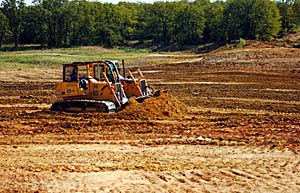
But, a drought is the time to consider renovating, if it's something which needs to be done. It's also the time to bring in the heavy equipment and rearrange some dirt, too... if your favorite bulldozer guy has you high enough on the waiting list.
Here's something not too many people consider during a drought. As water evaporates, all that leaves is that precious wet stuff. It's sucked straight into the air and onward to its next destination. Everything dissolved in that water over time is left behind. Remember this.. .in most ponds, the top three or four feet is about half the volume of the entire pond. When your pond drops so much due to evaporation, the dissolved minerals, metals, nutrients and organic content increases measurably. For example, if your pond measured 100 ppm alkalinity and half the volume of water evaporates, your alkalinity can go to 200 ppm. Since it happens over the course of weeks, maybe months, the flora and fauna adjust gradually. The pH may have shifted one or two points, too. When those filling rains come, guess what happens? Everything is diluted... fast. So fast, in some cases, that fish and plants are shocked and stressed to their death.
Monitor your water quality and learn how to amend it, if needed.
This summer, in our neck of the woods, excessive heat has led to abnormal problems. Funny, it doesn't seem that the excessive heat actually caused this problem...what caused it was how quickly the temperature rose. We saw water temperatures jump from 68 to 85 in a period of days, not weeks as normally happens. Several species of rooted aquatic plants, especially southern naiad, grew explosively, consuming many ponds in the region.
Here's why. As a pond comes to life each spring, things happen in order. Cool water plants grow. Fish which spawn in cooler water, do so. Then, the water warms a little bit more and different plants awaken. The next line of fish do their thing and babies are evident everywhere. This continues as spring blooms into summer, when a diverse plant community is harbor to many species of insects and baby fish grow into juveniles on their way to an orderly spot in the food chain.

But, when the temperatures rise so fast, several steps of that process are skipped. Some plants dominate that wouldn't ordinarily do so. Some fish don't have their window of opportunity. Things get out of whack, biologically. Then, moving further into the drought, water volume declines as the quality and chemistry changes and the stage is set for a shift...when the next rains inevitably come.
On the up side, I've seen some of the fastest growing fish I've ever witnessed do so during a drought. As the water recedes, fish are confined to a smaller area. Nature motivates them to adjust their numbers for the size of water. Big fish feed on smaller fish. As the drought continues, forage fish numbers drop, big fish grow considerably larger and fish numbers decline.
Then, when the rains come...as they inevitably do... "new" areas of terrestrial plant growth and fresh habitat are inundated. The pond or lake spreads out, increases in size and things change, again.
I'll always remember and cherish Pinto Valle Lake, northwest of Laredo, Texas. I cut my teeth in the 1980's, helping manage that lake. When it was full, it spanned most of 50 acres. It was a neat lake, full of huisache, cacti and other plants that stick you. It was also full of bass. Literally thousands of them. With a harvest plan, the owners pulled more than 3,000 bass out of there over three years. They had bass ceviche, bass kabobs, fried bass, bass stew... bass enchiladas...any recipe you might think of. Yes, we stocked forage fish, bluegill and later, threadfin shad. But, the amazing thing about this lake was how we were able to use fluctuating water levels to assist bass growth.
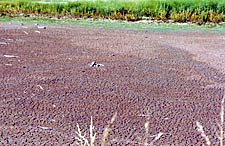
Laredo, Texas, is in the desert. Pinto Valle Lake sits about three miles from the Rio Grande. It doesn't rain much there. But, when it rains, it can be a deluge...from a summer tropical storm or hurricane making landfall a hundred miles away. That lake notoriously went from 50 acres at one time to 35 to 30 to 20...over a span of two years. When excess bass were finally harvested to the point that their remaining cousins could actually grow, it was amazing to watch how fast they gained weight. When the lake was full, after the dynamics were shifted through harvest, the lake teemed with baitfish. Then, it would draw down, baitfish were flushed out of the brush and bass ate them like a Sumo wrestler at an all-you-can-eat buffet table.
The lake dropped for year, maybe two, and it was "advantage bass". Then, a tropical event would happen; fill the lake to capacity, and it would be "advantage baitfish". This cycle went on for years and the lake record changed dramatically from year to year.
Drawdowns can be the thrust to adjust the dynamics of a fishery.
Know this...when a flood happens or a long term drought comes along, your pond or lake is affected. Part of your job is to assess how your precious body of water is affected. It might be a good thing.. .but there might be a few things to adjust. Change is inevitable...your job is to know what the change is, so you can be proactive, rather than reactive.
Reprinted with permission from Pond Boss Magazine


